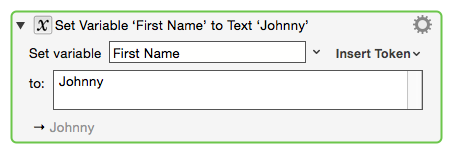**This is an old revision of the document!**
Table of Contents
Keyboard Maestro Variables
Keyboard Maestro variables are used much like variables in any scripting or macro language. They provide for the storage of data as determined by you, the Keyboard Maestro user.
However, they have one key difference from most other languages: The variable values are permanently stored on each Mac, and thus are available to all macros, and macros that run in the future. You can view your current list of variables on the Variables tab of Keyboard Maestro Editor Preferences.
Instead of software code, Keyboard Maestro variables are set by Macro Actions (or by scripts), and can then be used by other Macro Actions.
It should be noted that all Keyboard Maestro variables are text. However, you can use variables that contain numbers in calculations, by using the Calculate Token.
Setting Variables
The most common Action to set a variable is, well, Set Variable to Text.

There are a number of other Actions to set variables:
In addition to these, there are a number of more complex Actions that can also set a variable. The For Each Action is an example.
When setting a variable, you will be using a text field in most cases. 
Using Variables
There are many Macro Actions that can use variables. Some of these explicitly provide for entry of the variable name, but most provide for a more general entry of a Keyboard Maestro Token.
Variable Tokens
The %Variable%<VariableName>% token allows you to include a variable in a token text field,
where <VariableName> is the name of the variable.
For Example, using the Insert Text Action:

You can also use a short form of just %Variable Name% to include variables as long as the variable exists and has a value and there is no corresponding text token, although generally it is better and clearer to use the longer form %Variable%Variable Name%.
Variable Arrays
Variables can contain an array of comma separated numbers, like the image size (123,456) or window frame (100,120,600,550). In a calculation field, you can refer to these using a normal (1-based) index notation, like Variable[2]. So you can use ClipboardImageSize[1] and ClipboardImageSize[2].
It is important to note that variable arrays can contain only numeric values. When you use the %Calculate% function to reference a variable array element, it will convert the element to a number. So, in effect, you can only use variable arrays to store/reference numbers.
For example, suppose the variable MyArray has this value: 10,05,00,12. In any Keyboard Maestro Action where you would like to use the array element %Calculate%MyArray[2]%, it will return “5” because it has evaluated it as number, not the actual string of the element “05”.
Using Variables in Scripts
You can get and set Keyboard Maestro Variables in these types of scripts:
Click on the above links for example scripts.
